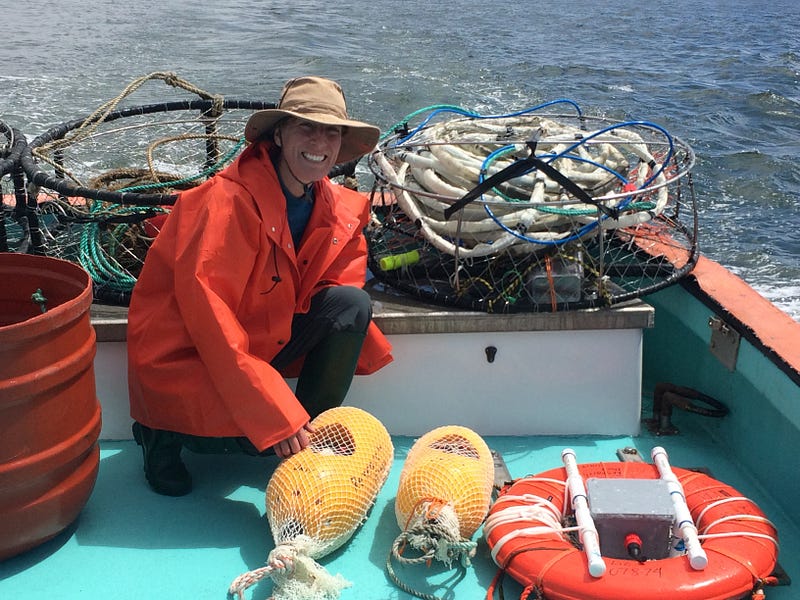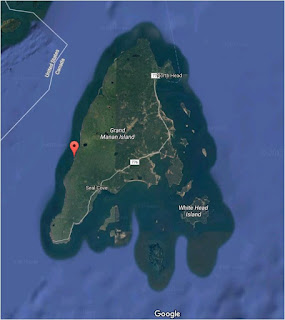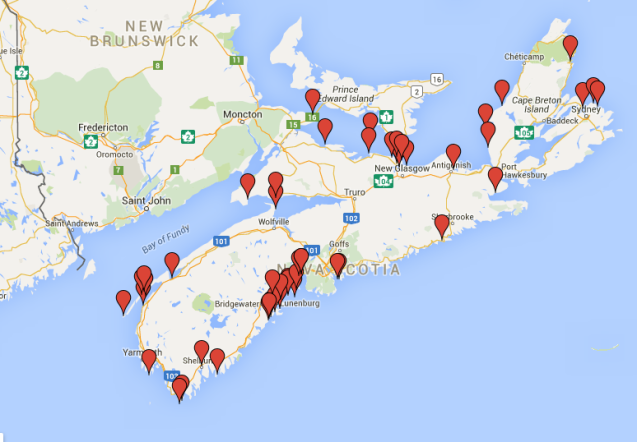FUNDY TREASURES: Pirate Ned Low, Captain Kidd and the Treasure of Isle Haute
by Art MacKay, 3/15/2017
Image taken at low tide at Harbourville, Nova Scotia
Isle Haute is a remote island in the middle of upper Bay of Fundy near the entrance to the Minas Basin, 16 kilometers from the coast of Harbourville and 8 kilometers south-southwest of Cape Chignecto, Nova Scotia. The island is part of Cumberland County, Nova Scotia and is 3 km long and 0.4 km wide. The Mi'kmaq used the island to make stone tools before Europeans arrived and called the island "Maskusetik", meaning place of wild potatoes. Samuel de Champlain gave the present name to the island, meaning in French "High Island", in 1604 when he observed the towering bluffs, timber and fresh-water springs. The steep 100 m (328 ft) basalt cliffs of the island are the result from volcanic eruptions in the Jurassic period and may have been connected to the North Mountain volcanic ridge on the mainland 200 million years ago, before the Bay of Fundy was formed.
In 1878, a lighthouse was built and was manned until 1956, when fire collapsed the lighthouse and home of the lighthouse keeper. The lighthouse was replaced by a steel tower and is unmanned. Federally owned, the island is being transferred from the Canadian Coast Guard to the Canadian Wildlife Service to protect its unique ecosystem. The island is also protected under Nova Scotia's Special Places Act to protect early Mi'kmaw archaeological sites. Digging without an archaeological permit or removal of artifacts is prohibited. (Modified from Wikipedia)
THE STORY
Many of us believe that a mystery unexplained remains a mystery and this seems to be true for Isle Haute, a particularly isolated and rugged island lying off Minas Basin in the Bay of Fundy. While the professionals that study and oversee the island believe that there is no evidence that pirates ever buried treasure there and go so far as to state that “no one has ever discovered any genuine pirate treasure in Nova Scotia”, people still continue the search for treasure left by vicious pirate Edward “Ned” Low or perhaps it was the ubiquitous Captain Kidd as some stories suggest. Whatever the truth, stories abound and treasure hunters have, apparently, pockmarked the island with holes in their quest to discover the treasure. One story places the treasure in a unique pond at one end of the island and it is claimed that there was even an attempt to drain the pond. Islands seem to attract attention as great places to buy and hide ill-gotten booty and Isle Haute is one of the best.

Early stories suggest the Acadians hid their valuables there during the expulsion and then there is Captain Kidd who seems to have buried his treasure everywhere.
But the established history of Captain Ned Low places him in the Fundy area. “Outrunning his pursuers following a raid on the New England coast, Pirate Ned and his crew arrived in the Minas Channel in 1722. Supposedly, Ned not only buried his booty on Isle Haute, he also sacrificed one of his crew, whose ghost would guard the treasure until Ned’s return. Ned never made it back, however, as he was captured, imprisoned and ended his career at the gallows, taking the secret location with him.” (novanewsnow.com)
In 1929 B.C. treasure hunter Douglas Carmichael made several trips to the island and reported his discovery of “jewels and coins”. His claims were never supported however and the truth of his discover remains unproven. While many years have passed and the individual is long past away, Edward Rowe Snow, an American adventurer and writer learned about the treasure of Isle Haute. He researched the subject and somehow, somewhere, obtained a map that was reputed to have been created by Ned Low himself. The map image clearly resembled Isle Haute and, equipped with his research and a professional metal detector, Snow arrived on the island in 1952 as a guest of the lighthouse keeper, John Fullerton and began his search. It apparently wasn’t long before he unearthed a human skeleton and in the same area a cache of silver and gold coins some dating back to 1710. His discovery was quickly seized by the authorities but a later application to the appropriate authorities resulted in the return of his coins. The world press picked up the story and he and Isle Haute became famous for a brief time. He published photos of his find in Life magazine, although it is open to question whether what he claimed to have found was treasure, shipwreck gold or merely a plant. Snow was candid in admitting that the real money in treasure hunting came not from finding anything but rather from writing about it and selling books.(see McLellan, 1955; Trueman, 1970; Snow, 1952). Unfortunately, Snow’s efforts and those of other treasure hunters have led to the pointless and frenzied digging on Isle Haute, which hold tragic consequences for the island’s history. The spot most favoured by Snow and other treasure hunters at one end of the pond also happens to be one of the more important archeological sites on the island.
HOW TO GET THERE
IS IT WORTH VISITING?
Beautiful, rugged, remote and inaccessible aptly describe Isle Haute. Originally managed by the Canadian Coast Guard, the lighthouse is long gone and only a tower serviced by a helicopter, guide the ships at night. Today, there is some confusion about who manages the island and Provincial professionals seem to think a permit is required. But at this time, it is uncertain how you apply. That said, a boat tour can be arranged and there are many, many other interesting places to explore, making the trip worthwhile and one that should be on your list.
Isle Haute has all of the elements of a great place to visit and based on all the comments I have seen, it is well worth the effort. There is only one way really and that is by boat. We recommend you contact Advocate Boat Tours to book you visit. Isle Haute is one of their favourite tours. Here’s part of what they have to say:
all 1-902-670-8314 or email onthebay@advocateboattours.com.
Remote Isle Haute is home to a large seal and bird colony. Copyright: paulillsley.com
Take an off-shore tour to the mysterious Isle Haute in the middle of the Bay of Fundy where numerous seals frolic in the clear water, and bald eagles, seagulls and peregrine falcons ride the updrafts along the cliffs. This destination is the highlight of any trip to Nova Scotia if you like wild, unspoiled nature and amazing geology. Our most popular tour, this is always a hit with the kids as well due to the awesome wildlife viewing opportunities.
IMAGES
RESOURCES
The Reference Files: These are the media and document files we use in preparing this guide provided as a single Zip File. It includes general information as well as information on the lighthouse, pirates, shipwrecks of the island, studies carried out and tourist services in the area. We save references as PDFs since we discovered that links tend to disappear taking important information with them. Please note the copyrights remain with the owners and apart from our guide all other media and documents are for references and fair use only. $7.99 Buy this on Selz
REFERENCES

 Photo Courtesy Blue Ocean Gear
Photo Courtesy Blue Ocean Gear



















